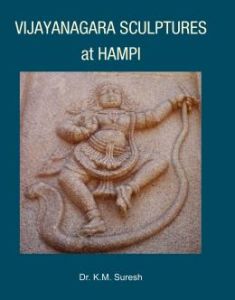
Contents: Foreword. Preface. 1. Introduction. 2. Historical perspective. 3. Art traditions prior to Vijayanagara. 4. Sculptural art during Vijayanagara period. 5. Shaiva sculptures. 6. Vaishnava sculptures. 7. Jaina sculptures. 8. Sculptures of minor divinities. 9. Sculptures of devotees. 10. Sculptures of devotees. Conclusion. Glossary. Bibliography. Index.
The Vijayanagara Empire with its capital at Hampi in Karnataka was founded by Harihara I of the Sangama dynasty around 1336 A.D. to preserve the Hindu Dharma their prevailing culture, social order and check the onslaughts of Islam in South India. The Vijayanagara emperors and their feudatories were highly learned persons and they did their best to sustain political freedom, preservation and popularization of Santana Hindu Dharma art literature, architecture, paining etc. Due to their characteristic tolerance and the compromising attitude of rulers, sculptures of different schools of thought flourished within their empire.
The Vijayanagara sculptures of Hampi (1336 to 1565 A.D.) had different religious influences as reflected in the sculptural representations of the prevailing faiths-Shaivism, Vaishnavism and Jainism. The present study on the Vijayanagara Sculptures at Hampi is grouped into five chapters. The introductory chapter deals with the sites and the environment covering Anegundi, Kamalpur, Kadirampura, Malapangudi, Ananthasayanagudi, Naganahalli, Hospet and Timmalapura. The second chapter is devoted to the historical perspective which shows that the foundation of the Vijayanagara empire in the 14 century was an epoch making event, not only in the history of Karnataka, but also of the whole of South India. It reveals that its founders were inspired by patriotic ideals embodied with the spirit of freedom and determination to sacrifice anything on that account. It covers from Harihara (1336 A.D.) to Sadasivaraya (1570 A.D.). The third chapter reflects on the art traditions prior to Vijayanagara. The Chalukyas (c. 450-755 A.D. were a great power in South India and the magnificent sculptures of Aihole, Badami and Pattadakal are due to their patronage. The sculptural art which flourished during the Vijayanagara period, as finds mention in the fourth chapter, was influenced by the literary works like the Vedas, Puranas, Epics and canons on iconography as codified in the Agamas. Chapters five, six and seven abundantly dwell on the Shaiva, Vaishnava and Jaina sculptures respectively. Minor divinities and devotees find description in the last two chapters of the book. The book is richly illustrated with plenty of sculptures of the various Gods.